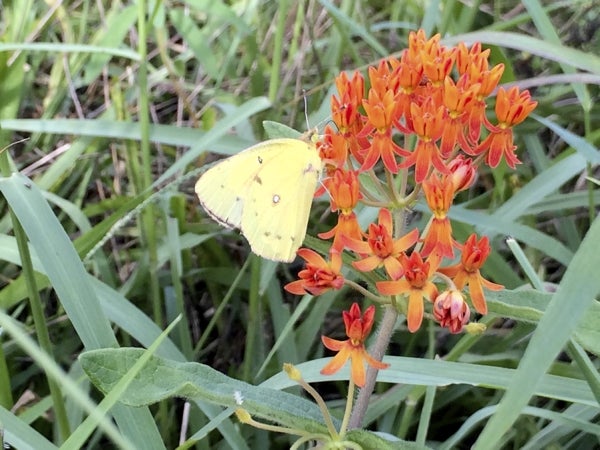Danélle Cutting: Bad bugs, beautiful butterflies
Published 12:00 am Friday, September 9, 2016

- Cooperative Extension photo A Dainty Sulphur on Aclepias tuberosa
We have had some beautiful weather lately and I hate to see it end. I hope we will have more coming soon. This week we have had lots of phone calls, emails and visits asking to identify insects and flowers. Below are a few questions we have received from homeowners out in their gardens.
Question: What is this insect? Is it good or bad?
Answer: Thankfully this was an insect I knew right off the bat. Unfortunately for the client, it is the pesky Harlequin bug and they love cool season vegetables. The client also brought in the eggs and they are almost always easy to identify because they have an interesting black and white swirl around the eggs. I have had these pests on my Brussels sprouts and they can quickly take over if you do not keep an eye out. Scouting is necessary — be sure to check on the tops and bottoms of all of the leaves. Don’t let their beautiful color fool you, these are definitely a pest of your vegetables. For more identification tools visit this website: https://growingsmallfarms.ces.ncsu.edu/growingsmallfarms-harlequinbug/
Question: What is this beautiful flower? It is blooming right now and the butterflies love it!
Answer: The photo I received showed one of our beautiful natives, it is Aclepias tuberosa also known as Butterfly Weed or milkweed. This plant is very important for Monarchs because it is a host plant for the larvae of Monarchs. We used to see many wild areas with this plant but due to development and managing roadways and ditches, wild populations have dwindled. They have beautiful orange, red and yellow flowers and since there has been a recent interest in building Monarch populations, many plant stores are starting to carry this plant. If you are interested in hosting a few butterflies and Monarchs, try some in your garden beds. For more info visit this website: https://plants.ces.ncsu.edu/plants/all/asclepias-tuberosa/
Question: I love butterflies and I will sometimes rear them in my home to protect them from the wild. Recently I noticed two wasps were in one of my cages, what are they? Do they hurt or injure my caterpillars?
Answer: When I first saw the wasps I was not entirely sure what species they were, but I was pretty sure that they were a type of parasitic wasps. Now, as most of you know there are many beneficial parasitic wasps and I always encourage people to be educated before they make any decision.
Unfortunately, what was in this client’s container was a parasitic wasp named Trogus pennator and it is a parasitic wasp of swallowtail butterflies. Females will attack the caterpillars and lay an egg inside of them. As the caterpillar creates its chrysalis, the wasp larvae will develop inside of the caterpillar. Once the wasps’ metamorphosing is complete, the wasp will chew a hole out of the chrysalis to escape and start the entire cycle again. It is kind of sad but all of the wasps play an important role in the cycle of life. Birds need caterpillars to feed their young and so do wasps that also help parasitize and feed on other insects.
Growing up, I never thought I would be as fascinated about insects, but as I have gotten older the more they have interested me and it is always interesting to learn about their lifecycle. I guess you never realize how important they are, till you learn about everything they do from pollination to helping reduce other pests.
If you would like to learn more about monarchs, pollinators, how to plant for pollinators, or how to identify some of your own insects call your local Cooperative Extension agent, Danélle Cutting at 704-216-8970.




